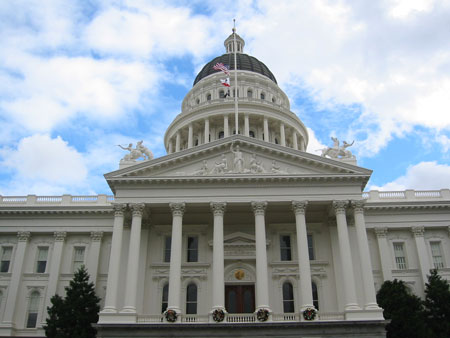New Poll Shows Support For Constitutional Reform
Comments (5)

The state capitol in Sacramento. While Californians want state government reform,
they don't yet agree how to get it. (Creative Commons licensed)
Results of a Field Poll released Wednesday suggest that while Californians may be open to reforming California's constitution, there is little agreement on what specific reforms need to be made or how to make them.
A 51 percent majority of those surveyed said there needed to be "fundamental change" made to the state constitution, and 51 percent of people also preferred a constitutional convention to make those changes, compared to a commission that would develop reform proposals.
The Bay Area Council, the main force behind the constitutional convention, hopes to get ballot initiatives on the November 2010 ballot that would call a convention for the next year.
John Grubb, the senior vice president for the Bay Area Council, said the results of the Field Poll matched with the organization's own polling data. He said reforming state government was critical.
"[California without reform] is the worst scenario Californians could imagine," Grubb said. "My worst fear is 'what does California look like in 10 years if we don't do anything'? We're focused on succeeding; we can talk later about what happens next if we don't get there."
While there may be tentative agreement that state government needs change, there is less support for some of the ideas proposed to reform it.
Mark DiCamillo, director of the Field Poll, said whether voters see the need for governmental reform and how they propose enacting that reform are two separate things.
"Voters want to do something that will unblock things," DiCamillo said. "They look at constitutional reform as something that will set things in motion. The rub is that when you start asking them about specific reforms, voters reject all of those things. They can agree on the process but it will be much, much harder to come up with solutions that will be palatable to the voter."
This rejection is seen in the Field Poll survey results. Critics of California's budgetary process say the two-thirds majority required to pass the budget leads to constant budget gridlock; only Arkansas and Rhode Island also require a two-thirds majority.
But survey respondents rejected that proposal, with 52 percent opposing it and 43 percent supporting it. Republican respondents strongly oppose this idea, with 69 percent against it.
Opposition to reforming Proposition 13, the 1978 law that required a two-thirds majority in the legislature to raise taxes and also changed how the state assesses property taxes, is even stronger. Sixty-nine percent of respondents oppose the idea of allowing the legislature to raise taxes with a simple majority vote.
Respondents also oppose reforming Proposition 13 so commercial properties are reassessed more frequently and taxed at market rates. Proponents say this will raise $4-5 billion annually; survey respondents opposed the idea 52 to 37 percent.
Proposals from the Commission on the 21st Century Economy, a bi-partisan commission appointed by the state, were strongly opposed by those surveyed, with only 23 percent of people supporting plans that would flatten state personal income taxes or replace the corporate income tax and state sales tax with a new net receipts tax.
DiCamillio said it might not be feasible to think of reforms in such broad terms.
"I am somewhat skeptical that the outcome of reform will be as ambitious as advocates are saying. You can get some things through and scale back objectives, but if you're trying to go after tax reform or Prop. 13 reform or changing votes in legislature, that won't happen."
Kris Vosburgh, the executive director of the Howard Jarvis Taxpayers Association, an anti-tax/pro business organization founded by the architect of Proposition 13, said the Field Poll data on support for Prop. 13 matched other surveys conducted by his organization.
"People don't want to change the two-thirds legislative requirement to change taxes," Vosburgh said. "Whether people want to change or not, people feel we are already one of highest tax states in the nation."
Grubb said the Bay Area Council's reform goals didn't go near touchy topics like Prop. 13 - frequently called "the third rail" of California politics.
"We have been saying until we are blue in the face that you can fix government in California without touching those issues," he said. "There are a ton of other things to tackle: Election processes, term limits, campaign finances, the initiative process, the bureaucracy of California's boards and agencies. Those things you can do quite successfully in const convention."
Vosburgh said that the HJTA believes the reform California needs is in the legislature - where politicians are "the enemy of common Californians." He called the potential constitutional convention a "nice day initiative" - something all voters want in theory, but a change that would also open the door to opportunities for abuse and influence by special interest groups.
Support for governmental reform in California is not completely bipartisan. While 57 percent of Democrats believe "fundamental changes" need to be made to the state constitution, only 42 percent of Republicans say so.
"Democrats and non-partisans seem to be on board, but the Republicans are not," DiCamillo said. "Where will Republicans be in three months? Will the opposition harden; will they get on board? I don't know the answer to that. That's the significant question for the future."
The Bay Area Council will be sending the finalized language for its two ballot measures (one to permit Californians to call a constitutional convention, and one to actually call it) to Jerry Brown, the California attorney general, within the next two weeks.
Next 10, a non-partisan group that sponsored the Field Poll survey, plans to develop a website to educate voters about the range of reform proposals put forward so far.
The Field Poll surveyed 1,005 registered California voters by phone over a two-week period in late September and early October. The survey responses have a margin of error of 3.2 percentage points.



